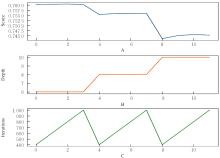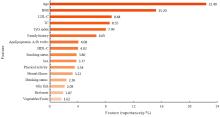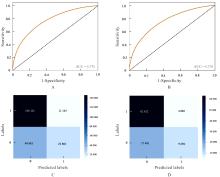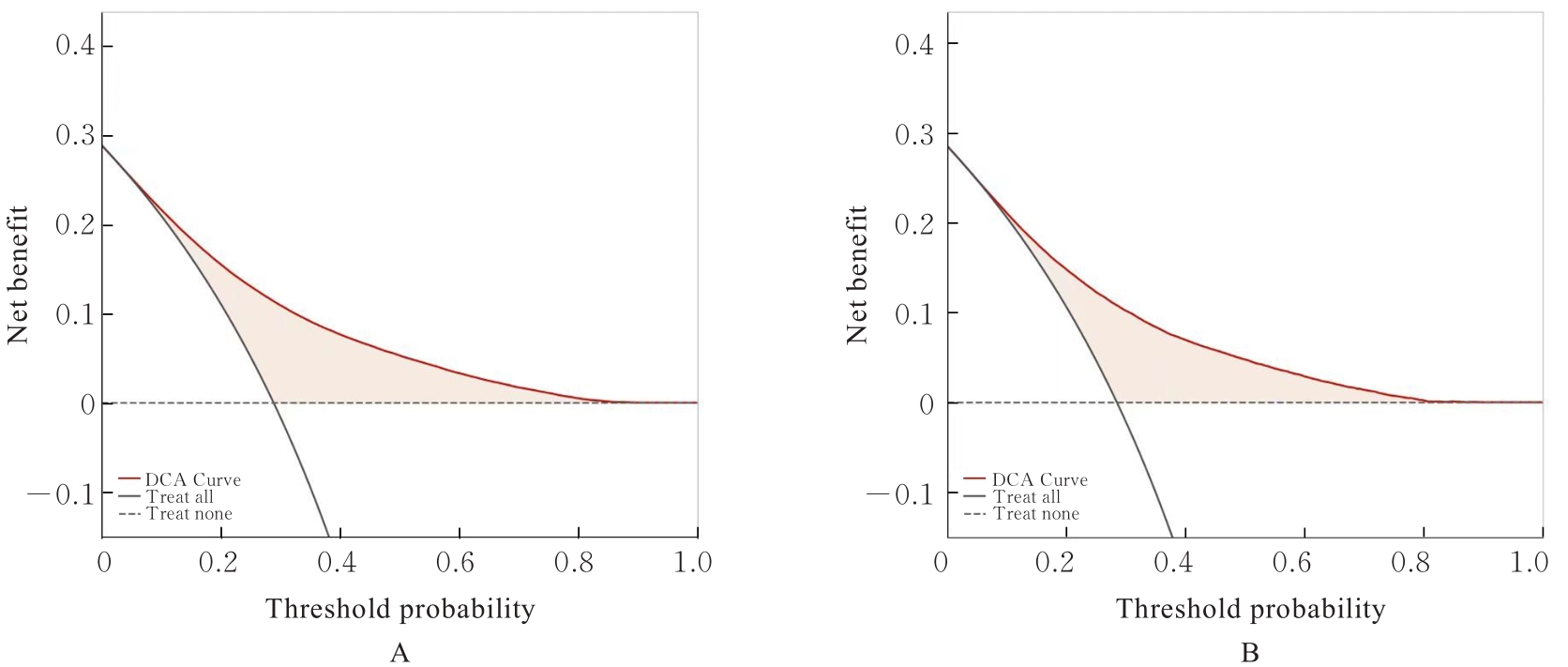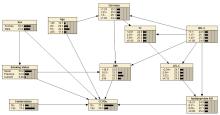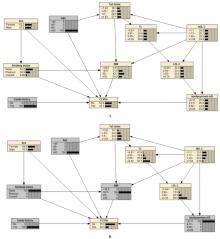吉林大学学报(医学版) ›› 2024, Vol. 50 ›› Issue (4): 1044-1054.doi: 10.13481/j.1671-587X.20240419
基于心脑血管疾病发病风险预测的CatBoost算法和贝叶斯网络模型分析
王爱民1,王凤琳1,黄一铭1,徐雅琪1,张文婧1,丛显铸1,苏维强1,王素珍1,高梦瑶1,李爽1,孔雨佳1,石福艳1( ),陶恩学2(
),陶恩学2( )
)
- 1.山东第二医科大学公共卫生学院卫生统计学教研室,山东 潍坊 261053
2.山东第二医科大学基础医学院,山东 潍坊 261053
-
收稿日期:2023-09-02出版日期:2024-07-28发布日期:2024-08-01 -
通讯作者:石福艳,陶恩学 E-mail:shifuyan@126.com;sdwftex@163.com -
作者简介:王爱民(2000-),男,山东省临沂市人,在读硕士研究生,主要从事卫生统计学方面的研究。 -
基金资助:国家自然科学基金项目(81803337);国家统计局科研项目(2018LY79);山东省科技厅自然科学基金项目(ZR2019MH034);山东省教育厅高等学校青创人才引育计划项目(2019-6-156);潍坊医学院博士启动基金项目(2017BSQD51)
CatBoost algorithm and Bayesian network model analysis based on risk prediction of cardiovascular and cerebro vascular diseases
Aimin WANG1,Fenglin WANG1,Yiming HUANG1,Yaqi XU1,Wenjing ZHANG1,Xianzhu CONG1,Weiqiang SU1,Suzhen WANG1,Mengyao GAO1,Shuang LI1,Yujia KONG1,Fuyan SHI1( ),Enxue TAO2(
),Enxue TAO2( )
)
- 1.Department of Health Statistics,School of Public Health,Shandong Second Medical University,Weifang 261053,China
2.School of Basic Medical Sciences,Shandong Second Medical University,Weifang 261053,China
-
Received:2023-09-02Online:2024-07-28Published:2024-08-01 -
Contact:Fuyan SHI,Enxue TAO E-mail:shifuyan@126.com;sdwftex@163.com
摘要:
目的 筛选影响心脑血管疾病发病的主要特征变量,基于排序前10位的特征变量构建心脑血管疾病发病风险贝叶斯网络模型,为心脑血管疾病发病风险预测提供参考。 方法 从英国生物样本(UK Biobank)数据库中纳入315 896例参与者和相关变量,通过类别型特征提升(CatBoost)算法进行特征选择,将所有参与者按7∶3比例随机分为训练集和测试集,并基于最大最小爬山(MMHC)算法构建贝叶斯网络模型。 结果 本研究中人群心脑血管疾病患病率为28.8%。CatBoost算法筛选的排名前10位变量分别为年龄、体质量指数(BMI)、低密度脂蛋白胆固醇(LDL-C)、总胆固醇(TC)、甘油三酯-葡萄糖(TyG)指数、家族史、载脂蛋白A/B比值、高密度脂蛋白胆固醇(HDL-C)、吸烟状态和性别。CatBoost训练集模型受试者工作特征(ROC)曲线下面积(AUC)为0.770,模型准确性为0.764;验证集模型AUC为0.759,模型准确性为0.763。临床效能分析,训练集阈值范围为0.06~0.85,验证集阈值范围为0.09~0.81。心脑血管疾病发病风险贝叶斯网络模型分析,年龄、性别、吸烟状态、家族史、BMI和载脂蛋白A/B比值与心脑血管疾病直接相关,是心脑血管疾病发生的重要风险因素,TyG指数、HDL-C、LDL-C和TC通过影响BMI和载脂蛋白A/B比值间接影响心脑血管疾病的发生风险。 结论 控制BMI、载脂蛋白A/B比值和吸烟行为,可以降低心脑血管疾病的发病风险。贝叶斯网络模型可用于预测心脑血管疾病发病风险。
中图分类号:
- R54
引用本文
王爱民,王凤琳,黄一铭,徐雅琪,张文婧,丛显铸,苏维强,王素珍,高梦瑶,李爽,孔雨佳,石福艳,陶恩学. 基于心脑血管疾病发病风险预测的CatBoost算法和贝叶斯网络模型分析[J]. 吉林大学学报(医学版), 2024, 50(4): 1044-1054.
Aimin WANG,Fenglin WANG,Yiming HUANG,Yaqi XU,Wenjing ZHANG,Xianzhu CONG,Weiqiang SU,Suzhen WANG,Mengyao GAO,Shuang LI,Yujia KONG,Fuyan SHI,Enxue TAO. CatBoost algorithm and Bayesian network model analysis based on risk prediction of cardiovascular and cerebro vascular diseases[J]. Journal of Jilin University(Medicine Edition), 2024, 50(4): 1044-1054.
表1
与心脑血管疾病发生相关的主要变量和赋值情况"
| Variable | Assign | Variable | Assign |
|---|---|---|---|
| Age (x1, year) | <45=0 | TC (x11, mmol·L-1) | <4.91=0 |
| 45-54=1 | 4.91-5.64=1 | ||
| 55-64=2 | 5.65-6.41=2 | ||
| ≥65=3 | ≥6.42=3 | ||
| Gender (x2) | Female=0 | LDL-C (x12, mmol·L-1) | <2.94=0 |
| Male=1 | 2.94-3.51=1 | ||
| Smoking status (x3) | Never=0 | 3.52-4.11=2 | |
| Previous=1 | ≥4.12=3 | ||
| Current=2 | HDL-C (x13, mmol·L-1) | <1.17=0 | |
| Drinking status (x4) | Never=0 | 1.17-1.39=1 | |
| Previous=1 | 1.40-1.67=1 | ||
| Current =2 | ≥1.68=3 | ||
| Family history (x5) | No=0 | BMI (x14, kg·m-2) | <18.5 = 0 |
| Yes=1 | 18.5-24.9=1 | ||
| Mental illness (x6) | No=0 | 25.0-29.9=2 | |
| Yes=1 | ≥30.0=3 | ||
| Physical activity (x7) | Low=0 | Apolipoprotein A/B ratio (x15) | <8.31=0 |
| Moderate=1 | 8.31-8.67=1 | ||
| High=2 | 8.68-9.07=2 | ||
| Vegetables/Fruits (x8,≥5 d-1) | No=0 | ≥9.08=3 | |
| Yes=1 | TyG index(x16) | <1.23=0 | |
| Red meat (x9, ≥2/week) | No=0 | 1.23-1.49=1 | |
| Yes=1 | 1.50-1.82=2 | ||
| Oily fish (x10, ≥1/week) | No=0 | ≥1.83=3 | |
| Yes=1 | CCVDs | No=0 | |
| Yes=1 |
表2
非心脑血管疾病组和心脑血管疾病组研究对象临床资料"
| Variable | Non-cardiovascular and cerebrovascular diseases | Cardiovascular and cerebrovascular diseases | χ2 | P |
|---|---|---|---|---|
| Age(year) | 17 796.741 | <0.01 | ||
| <45 | 29 941(9.48) | 3 762(1.19) | ||
| 45-54 | 74 686(23.64) | 17 591(5.57) | ||
| 55-64 | 89 276(28.26) | 43 955(13.91) | ||
| ≥65 | 31 175(9.87) | 25 510(8.08) | ||
| Gender | 3 301.340 | <0.01 | ||
| Female | 124 833(39.52) | 40 123(12.70) | ||
| Male | 100 245(31.73) | 50 695(16.05) | ||
| Smoking status | 2 065.759 | <0.01 | ||
| Never | 129 253(40.92) | 45 183(14.30) | ||
| Previous | 73 069(23.13) | 37 184(11.77) | ||
| Drinking status | 393.526 | <0.01 | ||
| Never | 8 159(2.58) | 3 949(1.25) | ||
| Previous | 6 746(2.14) | 3 813(1.21) | ||
| Current | 210 173(66.53) | 83 056(26.29) | ||
| Family history | 4 275.264 | <0.01 | ||
| Yes | 159 655(50.54) | 74 638(23.63) | ||
| No | 65 423(20.71) | 16 180(5.12) | ||
| Mental illness | 532.280 | <0.01 | ||
| Yes | 72 230(22.87) | 33 027(10.46) | ||
| No | 152 848(48.39) | 57 791(18.29) | ||
| Physical activity | 668.927 | <0.01 | ||
| Low | 39 911(12.63) | 19 262(6.10) | ||
| Moderate | 91 891(29.09) | 37 489(11.87) | ||
| High | 93 276(29.53) | 34 067(10.78) | ||
| Vegetables/Fruits(≥5 d-1) | 1.471 | 0.225 | ||
| Yes | 182 024(57.62) | 73 616(23.30) | ||
| No | 43 054(13.63) | 17 202(5.45) | ||
| Red meat (≥2/week) | 593.884 | <0.01 | ||
| Yes | 72 763(23.03) | 33 470(10.60) | ||
| No | 152 315(48.22) | 57 348(18.15) | ||
| Oily fish (≥1/week) | 558.101 | <0.01 | ||
| Yes | 124 776(39.50) | 54 525(17.26) | ||
| No | 100 302(31.75) | 36 293(11.49) | ||
| TC (mmol·L-1) | 11 031.944 | <0.01 | ||
| <4.91 | 44 548(14.10) | 33 847(10.71) | ||
| 4.91-5.64 | 58 769(18.60) | 21 358(6.76) | ||
| 5.65-6.41 | 61 435(19.45) | 18 473(5.85) | ||
| ≥6.42 | 60 326(19.10) | 17 140(5.43) | ||
| LDL-C (mmol·L-1) | 9 949.487 | <0.01 | ||
| <2.94 | 44 785(14.18) | 33 120(10.48) | ||
| 2.94-3.51 | 58 282(18.45) | 21 295(6.74) | ||
| 3.52-4.11 | 61 140(19.35) | 18 714(5.92) | ||
| ≥4.12 | 60 871(19.27) | 17 689(5.60) | ||
| HDL-C (mmol·L-1) | 7 270.807 | <0.01 | ||
| <1.17 | 47 390(15.00) | 30 458(9.64) | ||
| 1.17-1.39 | 55 303(17.51) | 24 100(7.63) | ||
| 1.40-1.67 | 59 873(18.95) | 20 047(6.35) | ||
| ≥1.68 | 62 512(19.79) | 16 213(5.13) | ||
| BMI (kg·m-2) | 17 839.780 | <0.01 | ||
| <18.5 | 1 350(0.43) | 203(0.06) | ||
| 18.5-24.9 | 87 643(27.74) | 17 399(5.51) | ||
| 25.0-29.9 | 95 984(30.38) | 39 796(12.60) | ||
| ≥30.0 | 40 101(12.69) | 33 420(10.58) | ||
| Apolipoprotein A/B ratio | 512.794 | <0.01 | ||
| <8.31 | 57 986(18.36) | 20 441(6.47) | ||
| 8.31-8.67 | 56 199(17.79) | 22 458(7.11) | ||
| 8.68-9.07 | 56 193(17.79) | 23 142(7.33) | ||
| ≥9.08 | 54 700(17.32) | 24 777(7.84) | ||
| TyG index | 8 133.568 | <0.01 | ||
| <1.23 | 65 110(20.61) | 15 186(4.81) | ||
| 1.23-1.49 | 58 735(18.59) | 20 715(6.56) | ||
| 1.50-1.82 | 54 162(17.15) | 25 197(7.98) | ||
| ≥1.83 | 47 071(14.90) | 29 720(9.41) |
表3
心脑血管疾病独立父节点的条件概率表 (η/%)"
| Variable | Risk | Variable | Risk |
|---|---|---|---|
| Age(year) | Gender | ||
| <45 | 12.5 | Female | 25.0 |
| 45-54 | 19.9 | Male | 33.1 |
| 55-64 | 33.0 | BMI (kg·m-2) | |
| ≥65 | 43.4 | <18.5 | 22.6 |
| Family history | 18.5-24.9 | 18.0 | |
| Yes | 31.9 | 25.0-29.9 | 28.7 |
| No | 20.2 | ≥30.0 | 44.7 |
| Smoking status | Apolipoprotein A/B | ||
| Never | 27.1 | <8.31 | 26.7 |
| Previous | 31.3 | 8.31-8.67 | 28.3 |
| Current | 29.9 | 8.68-9.07 | 28.6 |
| ≥9.08 | 31.6 |
| 1 | REN Q Q, LI S Y, XIAO C L, et al. The impact of air pollution on hospitalization for cardiovascular and cerebrovascular disease in Shenyang, China[J]. Iran J Public Health, 2020, 49(8): 1476-1484. |
| 2 | YOU Q, SHAO X Y, WANG J P, et al. Progress on physical field-regulated micro/nanomotors for cardiovascular and cerebrovascular disease treatment[J]. Small Methods, 2023, 7(10): e2300426. |
| 3 | BENJAMIN E J, MUNTNER P, ALONSO A, et al. Heart disease and stroke statistics-2019 update: a report from the American heart association[J]. Circulation, 2019, 139(10): e56-e528. |
| 4 | MENSAH G A, ROTH G A, FUSTER V. The global burden of cardiovascular diseases and risk factors: 2020 and beyond[J]. J Am Coll Cardiol, 2019, 74(20): 2529-2532. |
| 5 | DISEASES AND INJURIES COLLABORATORSGBD. Global burden of 369 diseases and injuries in 204 countries and territories, 1990-2019: a systematic analysis for the Global Burden of Disease Study 2019[J]. Lancet, 2020, 396(10258): 1204-1222. |
| 6 | MELA A, RDZANEK E, PONIATOWSKI Ł A, et al. Economic costs of cardiovascular diseases in Poland estimates for 2015-2017 years[J]. Front Pharmacol, 2020, 11: 1231. |
| 7 | QIAO W J, ZHANG X Y, KAN B, et al. Hypertension, BMI, and cardiovascular and cerebrovascular diseases[J]. Open Med, 2021, 16(1): 149-155. |
| 8 | STROKE COLLABORATORSGBD. Global, regional, and national burden of stroke and its risk factors, 1990-2019: a systematic analysis for the Global Burden of Disease Study 2019[J]. Lancet Neurol, 2021, 20(10): 795-820. |
| 9 | BOYD C, BROWN G, KLEINIG T, et al. Machine learning quantitation of cardiovascular and cerebrovascular disease: a systematic review of clinical applications[J]. Diagnostics, 2021, 11(3): 551. |
| 10 | CHEUNG C Y, XU D J, CHENG C Y, et al. A deep-learning system for the assessment of cardiovascular disease risk via the measurement of retinal-vessel calibre[J]. Nat Biomed Eng, 2021, 5(6): 498-508. |
| 11 | AZMI J, ARIF M, NAFIS M T, et al. A systematic review on machine learning approaches for cardiovascular disease prediction using medical big data[J]. Med Eng Phys, 2022, 105: 103825. |
| 12 | KELSHIKER M A, SELIGMAN H, HOWARD J P, et al. Coronary flow reserve and cardiovascular outcomes: a systematic review and meta-analysis[J]. Eur Heart J, 2022, 43(16): 1582-1593. |
| 13 | ZHENG P F, CHEN L Z, LIU P, et al. Identification of immune-related key genes in the peripheral blood of ischaemic stroke patients using a weighted gene coexpression network analysis and machine learning[J]. J Transl Med, 2022, 20(1): 361. |
| 14 | BIEDERMANN A, TARONI F. Bayesian networks and probabilistic reasoning about scientific evidence when there is a lack of data[J]. Forensic Sci Int, 2006, 157(2/3): 163-167. |
| 15 | BYCROFT C, FREEMAN C, PETKOVA D, et al. The UK Biobank resource with deep phenotyping and genomic data[J]. Nature, 2018, 562(7726): 203-209. |
| 16 | 黄夏璇, 黄 韬, 杨 瑞, 等. UK Biobank数据的应用介绍[J]. 中国循证医学杂志, 2022, 22(9): 1099-1107. |
| 17 | UCHAI S, ANDERSEN L F, THORESEN M, et al. Does the association between adiposity measures and prefrailty among older adults vary by social position?Findings from the Tromsø study 2015/2016[J]. BMC Public Health, 2024, 24(1): 1457. |
| 18 | MACH F, BAIGENT C, CATAPANO A L, et al. 2019 ESC/EAS Guidelines for the management of dyslipidaemias: lipid modification to reduce cardiovascular risk[J]. Eur Heart J, 2020, 41(1): 111-188. |
| 19 | PIZZI N J. Fuzzy quartile encoding as a preprocessing method for biomedical pattern classification[J]. Theor Comput Sci, 2011, 412(42): 5909-5925. |
| 20 | JAYAWARDENA R, SOORIYAARACHCHI P. The inside story of fruits; exploring the truth behind conventional theories[J]. Diabetes Metab Syndr, 2021, 15(6): 102085. |
| 21 | CHUDASAMA Y V, KHUNTI K K, ZACCARDI F, et al. Physical activity, multimorbidity, and life expectancy: a UK Biobank longitudinal study[J]. BMC Med, 2019, 17(1): 108. |
| 22 | 苗丰顺, 李 岩, 高 岑, 等. 基于CatBoost算法的糖尿病预测方法[J]. 计算机系统应用, 2019, 28(9): 215-218. |
| 23 | HANCOCK J T, KHOSHGOFTAAR T M. CatBoost for big data: an interdisciplinary review[J]. J Big Data, 2020, 7(1): 94. |
| 24 | 胡建锦, 熊 伟, 方陆明, 等. 基于距离相关系数和Catboost方法的森林蓄积量估测[J]. 中南林业科技大学学报, 2023, 43(5): 27-35. |
| 25 | PRABU S, THIYANESWARAN B, SUJATHA M, et al. Grid search for predicting coronary heart disease by tuning hyper-parameters[J]. Comput Syst Sci Eng, 2022, 43(2): 737-749. |
| 26 | ROUSSON V, ZUMBRUNN T. Decision curve analysis revisited: overall net benefit, relationships to ROC curve analysis, and application to case-control studies[J]. BMC Med Inform Decis Mak, 2011, 11: 45. |
| 27 | 唐 末. 基于循证医学及机器学习的中医药影响早中期结直肠癌预后模型研究[D]. 北京: 中国中医科学院, 2022. |
| 28 | 钟 璐, 薛付忠. 基于贝叶斯网络不确定性推理的肺癌风险预测模型[J]. 山东大学学报(医学版), 2023, 61(4): 86-94. |
| 29 | 王旭春, 宋伟梅, 潘金花, 等. MMPC-Tabu 混合算法的贝叶斯网络模型在高脂血症相关因素研究中的应用[J]. 中国卫生统计, 2022, 39(3): 345-350, 355. |
| [1] | 王晓雨,李冰,刘国晖. 炎症标志物在冠状动脉粥样硬化性心脏病诊断和治疗中应用的研究进展[J]. 吉林大学学报(医学版), 2024, 50(4): 1173-1181. |
| [2] | 张莉,夏彬凤,黄慧慧,王茹,孔敏,尹霞. 血管内皮生长因子及其受体抑制剂相关性高血压病理生理机制及临床诊疗的研究进展[J]. 吉林大学学报(医学版), 2024, 50(3): 854-863. |
| [3] | 刘星,刘佳丽,聂连桂,刘茂军,赵俊雄,汪刘洋,杨军. 二氧化硫对大鼠急性心肌缺血损伤后心肌纤维化的改善作用及其机制[J]. 吉林大学学报(医学版), 2023, 49(5): 1125-1133. |
| [4] | 李欣彤,汤赢,唐彤宇,陈更. 遗传性出血性毛细血管扩张症所致消化道出血的研究进展[J]. 吉林大学学报(医学版), 2023, 49(5): 1394-1399. |
| [5] | 巨名飞,刘超,马志刚,赵娟,王涂,王智昊. 残余胆固醇水平对急性冠脉综合征患者发病的预测价值[J]. 吉林大学学报(医学版), 2023, 49(3): 765-769. |
| [6] | 李畅,马梓珊,黄汕梅,银帮巧,陈枝凡,聂莎,张子谦,李力,刘鹰,唐耀平. 薏苡附子散对小鼠心肌缺血和血管内皮功能损伤的保护作用及其机制[J]. 吉林大学学报(医学版), 2023, 49(3): 580-589. |
| [7] | 王秋雨,张帅朋,徐熙若,李馨,商丽华. 肥厚型梗阻性心肌病患者并发二尖瓣关闭不全的机制及其治疗策略研究进展[J]. 吉林大学学报(医学版), 2023, 49(3): 802-810. |
| [8] | 李海涛, 李沁, 蔡飞, 胡国富, 滕云飞. 芹菜素对小鼠RAW264.7巨噬细胞极化和炎症反应的作用及其机制[J]. 吉林大学学报(医学版), 2023, 49(3): 549-556. |
| [9] | 赵荫涛, 杨莹莹, 张相钦, 郑璐, 徐亚威, 杨海波, 刘源. 卵泡抑素样蛋白1对阿霉素所致小鼠急性心肌损伤的改善作用及其机制[J]. 吉林大学学报(医学版), 2023, 49(3): 565-572. |
| [10] | 任周新,余海滨,梅晓峰,董浩然,沈俊岭,李建生. 补肺益肾组分方Ⅲ对大鼠实验性肺动脉高压的改善作用[J]. 吉林大学学报(医学版), 2023, 49(2): 280-288. |
| [11] | 余淑华,刘朏,吴倩倩,杨东伟. 藏红花素对自发性高血压大鼠血管内皮功能障碍及动脉粥样硬化的作用及其ROCK/JNK信号通路机制[J]. 吉林大学学报(医学版), 2022, 48(6): 1481-1489. |
| [12] | 范吉林,朱婷婷,田晓玲,刘思佳,苏静,张世亮. 基于房颤中circRNA-miRNA-mRNA网络构建和免疫细胞浸润的生物信息学分析[J]. 吉林大学学报(医学版), 2022, 48(6): 1535-1545. |
| [13] | 王玥,鲁美丽,王洪新. 黄芪甲苷对低氧诱导小鼠血管损伤的保护作用及其机制[J]. 吉林大学学报(医学版), 2022, 48(5): 1101-1108. |
| [14] | 张一凡,丁洁,杜敏,冯骁腾,刘萍. 丹酚酸B对小鼠动脉粥样硬化病变和巨噬细胞胞葬作用的影响及其机制[J]. 吉林大学学报(医学版), 2022, 48(3): 561-567. |
| [15] | 刘依侬,张强,徐立. 阿托伐他汀对Ox-LDL/β2GPⅠ/anti-β2GPⅠ诱导的血管内皮功能紊乱的改善作用及其机制[J]. 吉林大学学报(医学版), 2022, 48(2): 317-323. |
|
